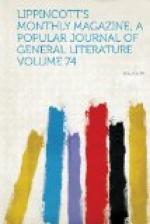It was not till 1852 that the Enfield rifle was settled on as the standard weapon of the British army. Machinery and machinists were imported for its fabrication from the United States, the appliances of our government armories being copied, and Colonel Bruton, of the Harper’s Ferry Works, employed to set them going. Prior to that time all firearms of public or private manufacture, in England, had been made by hand, the interchangeability of all the parts of any given number of guns being an end accomplished in this country alone. The advantage of having every corresponding detail of each piece a fac simile of the same part in all the firelocks of an army must have been perceived from the time when such weapons were first invented; and nothing but the most inveterate conservatism, or the steadiest opposition of that stamp which mobbed threshing-machines and the spinning-jenny, could have so long staved off its practical adoption.
Once awakened, however, England became, as she usually does, active, innovating and experimental enough. Rifled cannon, breech-loaders and armored ships—all the legitimate offspring of the Venetian barrel and its American employment—have kept her ever since in a ferment of boards, commissions and target-firing. But these would carry us beyond our prescribed limit into a boundless field of inquiry and description. It would be like passing from a notice of the tubular boiler of Stephenson’s Rocket to a discussion of the vast railway system it begot.
The Crimean war afforded the first test, on a large scale, in civilized warfare, of the issue between smooth and twist. How the conoidal bullet and rifled barrel, opposed at Inkermann to the antiquated Russian musket, tore through the dense columns which had forced their way to the brow of the plateau, driving the stolid Muscovites, “incapable of panic,” back into the ravine pell-mell—how, at many periods of the siege of Sebastopol, the rifle-pits did more to cripple the defence than did the mortars and battering-guns—we need not recount. These pits, and the rope mantlets wherewith they obliged the Russians to cover their embrasures, were pronounced by Captain (since General) George B. McClellan, in his report of the United States Military Commission, about the only marked novelties of the siege. Of both, mutatis mutandis, he and his opponents made effective use in our civil war.




